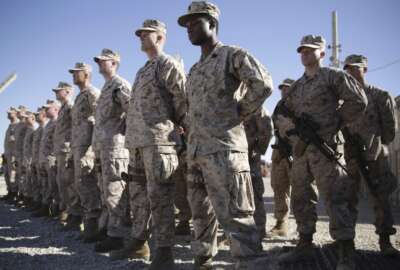
The Air Force says it expects a small number of airmen to end up getting laid off under DoD's new policy.
Subscribe to Federal Drive’s daily audio interviews on Apple Podcasts or PodcastOne.
ORLANDO, FLORIDA – After the Defense Department ordered the military branches to prepare to offload medically nondeployable troops, the Air Force is beginning its assessment of who in its ranks will actually get pink slips by the end of the year.
Air Force Secretary Heather Wilson said the service is currently developing guidance, while also waiting for DoD to send down its official instruction on the matter.
Wilson told reporters Feb. 22 at the Air Force Association Air Warfare Symposium that the military branch she oversees may not see the impacts from the new policy as intensely as other services.
“The Air Force has had a lower percentage of nondeployable people than the other services historically. We also have some career fields that don’t deploy at all,” Wilson said. “I would expect we would try to implement [the DoD] policy with two priorities in mind. One is the lethality and readiness of the force overall to be able to fight. The second is fairness. There is an argument that says if you have 100 people that can do a job and 10 of them that are nondeployable, the other 90 are carrying the greater burden. If that’s true then we’ve got to do things that are fair.”
The issue with beginning to push out troops who have not been deployable for the past year is figuring out who is nondeployable and why.
The Air Force and other services are now trying to figure out who in their ranks are nondeployable and if they can get back to deployable status.
DoD Undersecretary for Personnel and Readiness Robert Wilkie told Congress earlier this month that being nondeployable can be something as simple as not visiting the dentist.
The other issue surrounding ousting nondeployable troops is how to refill the ranks. The military is already competing with private industry for talented individuals and the pool from which the military can take employees from is small. The Pentagon estimates only about 25 percent of people between 17 and 34 are eligible to serve.
At the same time Congress and the Trump administration want to grow the military. The Air Force is tasked with growing to 325,000 airmen and the 2019 budget request bumps end strength up to almost 330,000.
Wilson and Commander of Air Education and Training Command Lt. Gen. Steven Kwast did not seem worried about finding the people to fill the spots.
“We have a fairly small number of people who are not deployable. We are pulling numbers now. You have to be nondeployable for over 12 months and they accept wounded warriors and they accept those who are pregnant or postpartum … We need to look at who is permanently nondeployable, what are their skill sets, do they even have to deploy?” Wilson said.
Kwast, who is in charge of recruitment, seemed optimistic about the Air Force’s ability to handle the challenge.
“If we have a nice network model of being able to have insight into the talent in civil society, we can find people who have the fitness to be able to deploy and the talent to do the jobs we need done. It doesn’t have to be one or the other. It can be both, but only if we have a deep enough pool of people we can reach and deep enough pool of people we can measure the talent of and then marry it up with our needs,” Kwast said. “There are 330 million people in America.”
DoD announced it is cracking down on the roughly 286,000 troops who are not deployable overseas last week.
Military services may start laying off service members who have not been deployable for a year and the branches will be required to get rid of them starting in October.
The policy exempts pregnant and postpartum service members, but they are the only group getting a pass.
Troops who have been non-deployable for more than a year may obtain a waiver from the secretary of their military department to stay in the service.
The military may also begin separating a person from the service once a determination has been made that he or she will remain non-deployable for more than a year. The military does not have to wait the full year.
Medical boards will review the conditions of those who have been wounded.
Service members will be given disability or administrative separation.
“The situation we face today is really unlike anything we have faced, certainly in the post-World War II era,” Wilkie said during a Feb. 14, Senate Armed Services Personnel Subcommittee hearing. “If Mr. [Jeff] Bezos at Amazon walked into Christmas week and 14 percent of his workforce could not perform their duties then [it] would no longer be the largest company in the world.”
Copyright © 2025 Federal News Network. All rights reserved. This website is not intended for users located within the European Economic Area.
Scott Maucione is a defense reporter for Federal News Network and reports on human capital, workforce and the Defense Department at-large.
Follow @smaucioneWFED
